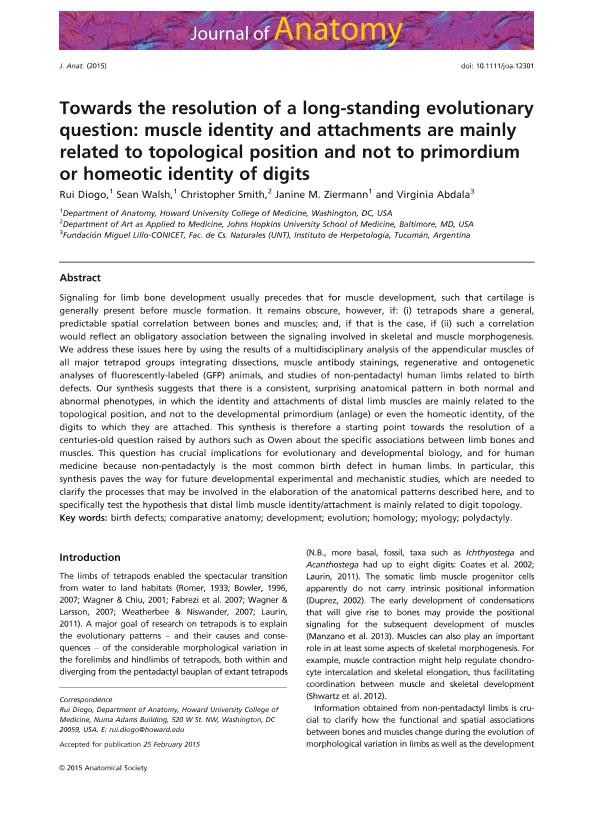Mostrar el registro sencillo del ítem
dc.contributor.author
Diogo, Rui
dc.contributor.author
Walsh, Sean
dc.contributor.author
Smith, Christopher
dc.contributor.author
Ziermann, Janine M.
dc.contributor.author
Abdala, Virginia Sara Luz

dc.date.available
2017-12-13T18:31:35Z
dc.date.issued
2015-04
dc.identifier.citation
Diogo, Rui; Walsh, Sean; Smith, Christopher; Ziermann, Janine M.; Abdala, Virginia Sara Luz; Towards the resolution of a long-standing evolutionary question: muscle identity and attachments are mainly related to topological position and not to primordium or homeotic identity of digits; Wiley; Journal Of Anatomy; 226; 6; 4-2015; 523-529
dc.identifier.issn
0021-8782
dc.identifier.uri
http://hdl.handle.net/11336/30491
dc.description.abstract
Signaling for limb bone development usually precedes that for muscle development, such that cartilage is generally present before muscle formation. It remains obscure, however, if: (i) tetrapods share a general, predictable spatial correlation between bones and muscles; and, if that is the case, if (ii) such a correlation would reflect an obligatory association between the signaling involved in skeletal and muscle morphogenesis. We address these issues here by using the results of a multidisciplinary analysis of the appendicular muscles of all major tetrapod groups integrating dissections, muscle antibody stainings, regenerative and ontogenetic analyses of fluorescently-labeled (GFP) animals, and studies of non-pentadactyl human limbs related to birth defects. Our synthesis suggests that there is a consistent, surprising anatomical pattern in both normal and abnormal phenotypes, in which the identity and attachments of distal limb muscles are mainly related to the topological position, and not to the developmental primordium (anlage) or even the homeotic identity, of the digits to which they are attached. This synthesis is therefore a starting point towards the resolution of a centuries-old question raised by authors such as Owen about the specific associations between limb bones and muscles. This question has crucial implications for evolutionary and developmental biology, and for human medicine because non-pentadactyly is the most common birth defect in human limbs. In particular, this synthesis paves the way for future developmental experimental and mechanistic studies, which are needed to clarify the processes that may be involved in the elaboration of the anatomical patterns described here, and to specifically test the hypothesis that distal limb muscle identity/attachment is mainly related to digit topology.
dc.format
application/pdf
dc.language.iso
eng
dc.publisher
Wiley

dc.rights
info:eu-repo/semantics/openAccess
dc.rights.uri
https://creativecommons.org/licenses/by-nc-sa/2.5/ar/
dc.subject
Birth Defects
dc.subject
Comparative Anatomy
dc.subject
Development
dc.subject
Evolution
dc.subject.classification
Otras Ciencias Biológicas

dc.subject.classification
Ciencias Biológicas

dc.subject.classification
CIENCIAS NATURALES Y EXACTAS

dc.title
Towards the resolution of a long-standing evolutionary question: muscle identity and attachments are mainly related to topological position and not to primordium or homeotic identity of digits
dc.type
info:eu-repo/semantics/article
dc.type
info:ar-repo/semantics/artículo
dc.type
info:eu-repo/semantics/publishedVersion
dc.date.updated
2016-12-28T16:31:17Z
dc.journal.volume
226
dc.journal.number
6
dc.journal.pagination
523-529
dc.journal.pais
Estados Unidos

dc.journal.ciudad
Hoboken
dc.description.fil
Fil: Diogo, Rui. Howard University. College of Medicine; Estados Unidos
dc.description.fil
Fil: Walsh, Sean. Howard University. College of Medicine; Estados Unidos
dc.description.fil
Fil: Smith, Christopher. University Johns Hopkins; Estados Unidos
dc.description.fil
Fil: Ziermann, Janine M.. Howard University. College of Medicine; Estados Unidos
dc.description.fil
Fil: Abdala, Virginia Sara Luz. Fundación Miguel Lillo; Argentina. Consejo Nacional de Investigaciones Científicas y Técnicas; Argentina
dc.journal.title
Journal Of Anatomy

dc.relation.alternativeid
info:eu-repo/semantics/altIdentifier/doi/http://dx.doi.org/10.1111/joa.12301
dc.relation.alternativeid
info:eu-repo/semantics/altIdentifier/url/http://onlinelibrary.wiley.com/doi/10.1111/joa.12301/abstract
Archivos asociados
